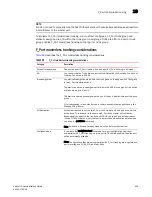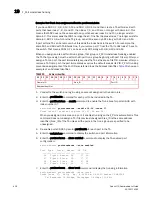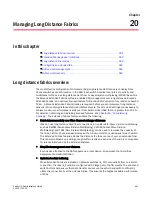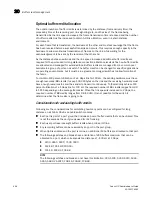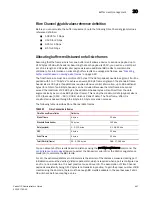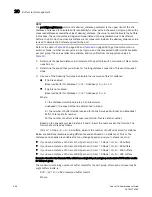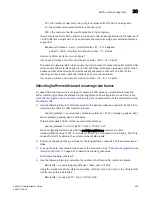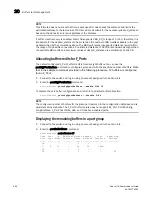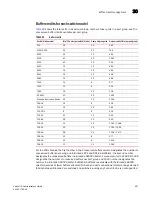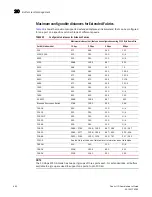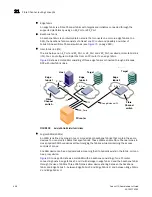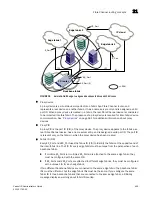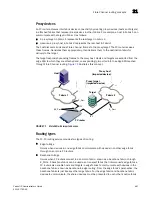
446
Fabric OS Administrator’s Guide
53-1001763-02
Buffer credit management
20
Optimal buffer credit allocation
The optimal number of buffer credits is determined by the distance (frame delivery time), the
processing time at the receiving port, link signaling rate, and the size of the frames being
transmitted. As the link speed increases, the frame transmission time is reduced and the number
of buffer credits must be increased to obtain full link utilization, even in a short-distance
environment.
For each frame that is transferred, the hardware at the other end must acknowledge that the frame
has been received before a successful transmission occurs. This requires enough capacity in the
hardware to allow continuous transmission of frames on the link, while waiting for the
acknowledgement to be sent by the receiver at the other end.
As the distance between switches and the link speed increases, additional buffer credits are
required for the ports used for long-distance connections. Distance levels define how buffer credits
are allocated and managed for extended ISLs. Buffer credits are managed from a common pool
available to a group of ports on a switch. The buffer credit can be changed for specific applications
or operating environments, but it must be in agreement among all switches to allow formation of
the fabric.
To maintain 100 percent utilization of a 1 Gbps link for 100 km, the sending hardware must have
enough resources (BB credits) to keep 106,250 bytes on the link and the receiving hardware must
have enough resources to allow the sender to transmit continuously. To theoretically achieve 100
percent utilization of a 1 Gbps link for 100 km, the required number of BB credits ranges from 49
to 1155 depending on the average frame size. When the link speed is increased to 2 Gbps, the
required number of BB credits ranges from 98 to 2310. It is not possible for the switch to
determine what the frame size is going to be.
Considerations for calculating buffer credits
Following are the considerations for calculating how many ports can be configured for long
distance on all Fabric OS v6.x capable switch modules:
•
Each port is part of a port group that includes a pool of buffer credits that can be utilized. This
is not the same as the port groups used for ISL Trunking.
•
Each user port reserves eight buffer credits when online or offline.
•
Any remaining buffers can be reserved by any port in the port group.
•
When QoS is enabled and the port is online, an additional 14 buffers are allocated to that port.
•
The following switches and blades have a limitation of 255 buffers maximum that can be
allocated to a port, which corresponds to a distance of ~500 km at 1 Gbps:
-
4100, 4900, 5000, 7500, 7600
-
FA4-18, FC4-16IP, FR4-18i
-
FC4-16, FC4-32, FC4-48
NOTE
The following switches and blades do not have this limitation: 300, 5100, 5300, 5410, 5424,
5450, 5480, VA-40FC, FC8-16, FC8-32, FC8-48.
Summary of Contents for 53-1001763-02
Page 1: ...53 1001763 02 13 September 2010 Fabric OS Administrator s Guide Supporting Fabric OS v6 4 0 ...
Page 4: ...iv Fabric OS Administrator s Guide 53 1001763 02 ...
Page 24: ...xxiv Fabric OS Administrator s Guide 53 1001763 02 ...
Page 28: ...xxviii Fabric OS Administrator s Guide 53 1001763 02 ...
Page 32: ...xxxii Fabric OS Administrator s Guide 53 1001763 02 ...
Page 40: ...xl Fabric OS Administrator s Guide 53 1001763 02 ...
Page 42: ...2 Fabric OS Administrator s Guide 53 1001763 02 ...
Page 54: ...14 Fabric OS Administrator s Guide 53 1001763 02 High availability of daemon processes 1 ...
Page 74: ...34 Fabric OS Administrator s Guide 53 1001763 02 Basic connections 2 ...
Page 102: ...62 Fabric OS Administrator s Guide 53 1001763 02 Audit log configuration 3 ...
Page 214: ...174 Fabric OS Administrator s Guide 53 1001763 02 Management interface security 7 ...
Page 228: ...188 Fabric OS Administrator s Guide 53 1001763 02 Brocade configuration form 8 ...
Page 276: ...236 Fabric OS Administrator s Guide 53 1001763 02 Creating a logical fabric using XISLs 10 ...
Page 404: ...364 Fabric OS Administrator s Guide 53 1001763 02 ...
Page 440: ...400 Fabric OS Administrator s Guide 53 1001763 02 Performance data collection 17 ...
Page 480: ...440 Fabric OS Administrator s Guide 53 1001763 02 F_Port masterless trunking 19 ...
Page 494: ...454 Fabric OS Administrator s Guide 53 1001763 02 Buffer credit recovery 20 ...
Page 574: ...534 Fabric OS Administrator s Guide 53 1001763 02 Hexadecimal overview E ...




